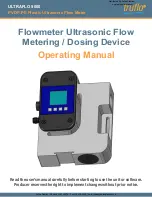
RT-Range User Manual
Revision: 190902
41
7.
In the unlikely event that the RTK Integer solution is incorrect at the start then the
Kalman filter can update the secondary antenna orientation incorrectly. If this
happens then things start to go wrong. The Kalman filter becomes more convinced
that it is correct, so it resolves faster, but it always solves incorrectly. Solving
incorrectly makes the situation worse than operating with single antenna.
To avoid the Kalman filter from getting things wrong it is possible to drive a
calibration run, then use the Improve configuration wizard
within NAVconfig (see
page 84 for more information). This tells the Kalman filter it has already estimated
the angle of the secondary antenna in the past and it will be much less likely to get it
wrong or change it. This step should only be done if the is permanently
mounted in a vehicle and the antennas are bolted on. Any movement of either the
or the antennas will invalidate the optimisation in the Kalman filter states.
Multipath effects on dual antenna systems
Dual antenna systems are very susceptible to the errors caused by multipath. This can
be from buildings, trees, roof-bars, etc. Multipath is where the signal from the satellite
has a direct path and one or more reflected paths. Because the reflected paths are not
the same length as the direct path, the GNSS receiver cannot track the satellite signal
as accurately.
The dual antenna system in the works by comparing the carrier-phase
measurements of the two antennas from common GNSS satellites. This tells the system
the relative distance between the two antennas and which way they are pointing (the
heading). For the heading to be accurate the GNSS receivers must measure the relative
position to about 3 mm. The level of accuracy can only be achieved if there is little or
no multipath.
In an ideal environment, with no surrounding buildings, trees, road signs or other
reflective surfaces, the only multipath received is from the vehicle’s roof. The antennas
supplied with the are designed to minimise multipath from the vehicle’s roof
when the roof is made of metal. For use on non-metallic roofs a different type of
antenna is required.
When stationary the heading from the will show some error; the size of the
error depends on the multipath in the environment. Table 19 lists the errors to be
expected when stationary with a 1 m base-line.
Содержание Survey+ v3
Страница 64: ...64 Oxford Technical Solutions ...
Страница 100: ......
Страница 101: ......
Страница 102: ......
Страница 103: ......
















































